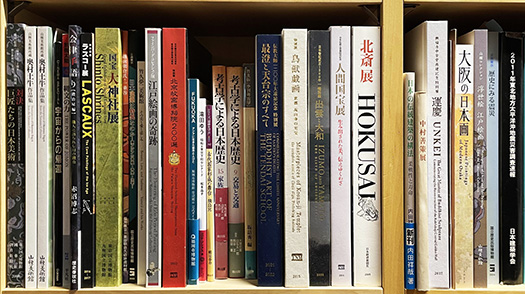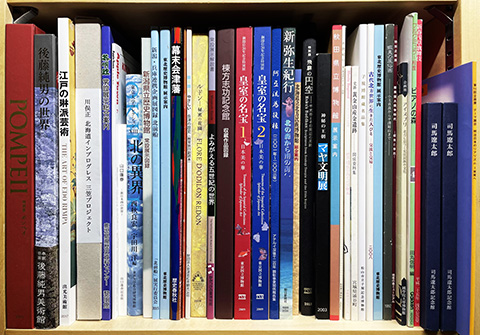

みなさんはどうであるかよくわかりませんが、わたしの場合、常備的で毎日参照する書斎の本棚はおおむねの趣味傾向や仕事関係の情報などが反映されています。
で、ときどきは使い勝手を考えて、断捨離を繰り返している。常時参照したい書類・書籍以外はときどき別の書棚に移行してもらって、つねに最新の興味傾向が色濃く反映されるようになる。その契機として断捨離は欠かせません。そうやっていまの興味分野に即して整理整頓したら、ずっと溜め続けていてその中身の整理整頓が追いついていないことが浮き彫りにもなってくる。
仕事の旅先で、残余時間が発生するとその地域の博物館・美術館などで、その土地や特定テーマについてなるべく参観するようにしている。その土地での暮らし方を「取材・整理」するには、そういった背景への知見が深まれば深まるほど、奥行き理解が進むのですね。
ただ、あまりにも次から次へとそういう情報が積層されて、整理整頓がまったく手に着かない。
写真の書籍などはふつうの書店で購入したモノはほとんどなくて、その多くは博物館などの展示イベントの「図録」類が大半です。
人間の知識活動は、まずは体験することが基盤を形成する。「見る」というのは、動物としての人間の情報活動の基本でしょう。そこからインパクトを受けてから文字情報・絵画情報などへと深まっていく。
ここに集約させたものはほぼ「図録類」ですが、このほかにも関連してのテキスト情報や冊子・カタログ類などもこれらの数倍の点数がある。それらを整理整頓させてみたら、案の定、
1 北海道
2 東北
3 関東
4 東京
5 中部
6 関西
7 とくに奈良県
8 兵庫を含む中国圏
9 四国
というように、地理分類が可能なように分散的に一定のボリュームで資料が積層していた。
東京は国立博物館展示が多く、それらは国外の文物に関連したものも多い。そしてその図録制作のあとがきなどを確認するとさすがにその領域の中核的な研究者などが監修していて、公平性に配慮された研究知見が反映されていることがわかる。
柳田國男さんや日本民藝運動の時代には手探りされていたような領域が、現代では各地の博物館施設の充実などで、みごとにスポットライトが照射されている。結局、こういった日本社会の先達のみなさんの開かれた道を、紆余曲折しながら暗中模索しているということなのでしょう。
こういうあたたかい「繭」に中から自分なりの問題意識に惹かれて、情報を整理整頓させながら、いろいろな見方を紡いでいきたい。自分の「数寄」が見える化しているようで、楽しい(笑)。
English version⬇
[Decluttering of documents and bookshelves and reaffirmation of my tendency toward “numismatics”].
After all, it is clear that I have lived my life deeply devoted to things like “folklore. I have several times as many materials from various regions of Japan as I had in the past. A wealth of themes to explore, a treasure trove of treasures. Themes and treasures.
I don’t know about you, but in my case, the bookshelves in my study, which I use regularly and refer to every day, generally reflect my hobbies and work-related information.
And sometimes, I keep decluttering them for ease of use. Except for documents and books that I want to refer to constantly, I sometimes have them moved to another bookshelf so that they always reflect the latest interest trends in a strong color. This is an indispensable opportunity for this process. When you reorganize your books in line with your current interests, it also brings to light the fact that you have been accumulating books for a long time and have not kept up with the organization of their contents.
When I travel for work and have time left over, I try to visit local museums and art galleries to learn about the local area and specific themes. In order to “cover and organize” the way of life in a place, the deeper my knowledge of such background, the more depth understanding I can gain.
However, the information is piled up one after another, so much so that it is difficult to keep things in order.
Most of the books on photography I have purchased at ordinary bookstores are “catalogs” of exhibition events at museums and other places.
The foundation of human knowledge is formed through experience. Seeing” is the basis of information activity for humans as animals. From there, after receiving impact, it deepens into textual and pictorial information.
The collection I have assembled here is mostly “catalogs,” but there are also several times as many related textual information, booklets, catalogs, etc. as these. When I tried to organize them, it was as I expected,
1 Hokkaido
2 Tohoku
3 Kanto
4 Tokyo
5 Chubu
6 Kansai
7 Especially Nara
8 Chugoku area including Hyogo
9 Shikoku
In this way, the materials were stacked in a dispersed and constant volume to enable geographical classification.
Tokyo has many national museum exhibits, and many of them are related to artifacts from outside Japan. The postcards in the catalogs show that they were supervised by core researchers in the field, and that they reflect the findings of impartial research.
The areas that were explored in the days of Kunio Yanagida and the Japan Folk Art Movement are now in the spotlight thanks to the enhancement of museum facilities around the country. In the end, we are still groping in the dark, taking twists and turns along the path opened to us by the predecessors of Japanese society.
I would like to weave various views from within these warm “cocoons,” attracted by my own awareness of the issues, while keeping the information in order. It is fun to see my “sukiyomi” becoming visible (laughs).
Posted on 2月 13th, 2024 by 三木 奎吾
Filed under: 日本社会・文化研究







コメントを投稿
「※誹謗中傷や、悪意のある書き込み、営利目的などのコメントを防ぐために、投稿された全てのコメントは一時的に保留されますのでご了承ください。」
You must be logged in to post a comment.